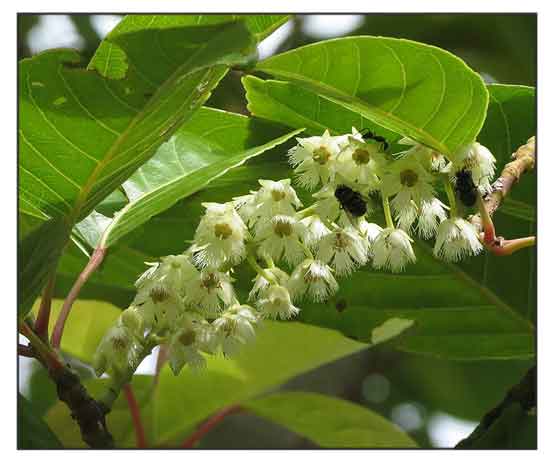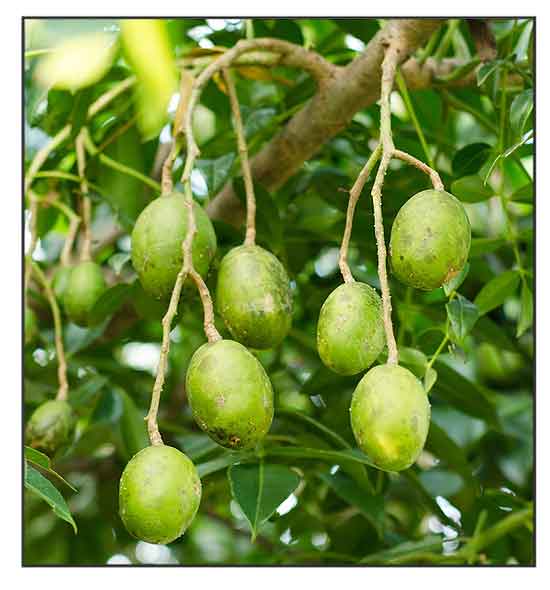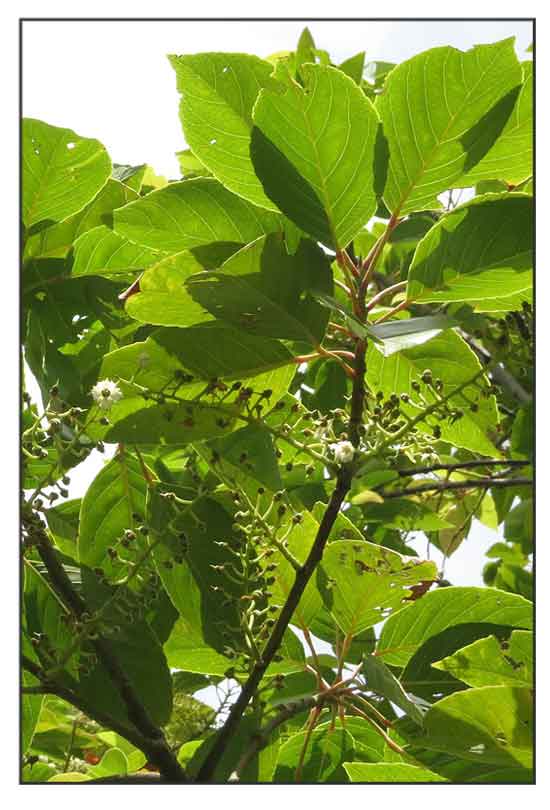 Gen info Gen info
- Elaeocarpus is a genus of nearly 500 species of flowering plants in the family Elaeocarpaceae. They are trees or shrubs with simple leaves, flowers with four or five petals, and, usually, a blue fruit. (5)
- The genus Elaeocarpus was first formally described in 1753 by Carl Linnaeus in Species Plantarum.
- Etymology: The genus name Elaeocarpus derives from Greek, meaning "olive-fruited". Specific epithet floribundus derives from Latin, meaning "with many flowers".
Botany
• Trees 15-25 m tall with buttresses; crown ovoid or oblong; bark gray-brown, vertically fissured. Leaves simple, alternate, spiral; petioles ca. 3-5 cm long, thickened at both ends, geniculate, glabrous, occasionally with a pair of gland at apex; lamina ca. 5-17 x 2-8 cm, broadly ovate or elliptic-ovate, cuneate or rounded at base, bluntly acuminate at apex, coarsely repand-serrate, subcoriaceous, glabrous, glandular-punctate beneath, pustulate when dry, bright red before falling; secondary nerves 5-7 pairs. Inflorescences in axillary racemes ca. 10-15 cm long, flower-buds ellipsoid, sericeous; flowers ca. 7 mm across, white; pedicels ca. 8-10 mm long, puberulous or glabrescent; sepals ca. 5-7 mm long, lanceolate, thickened and tomentose along margins; petals ca. 5-7 mm long, white, obtriangular, laciniate, ciliate along margins; stamens 25-30; filaments ca. 1 mm long, slender, minutely puberulous; anthers ca. 2 mm long, oblong, puberulous, bearded; disc silky villous; ovary 3-loculed, silky villous. Drupes ca. 2.5-4 cm long, light green, oblong-pyriform, rounded at both end, fleshy; pyrenes ca. 1.5-2 cm, spindle shaped, vertically 3-grooved, rugulose. (3)
• An evergreen tree up to 50 m tall; leaves often crowded at apices of pubescent, glabrescent twigs, oblong, elliptical to obovate, (3-)8-17(-22) cm x (2-)3-7(-9) cm, base cuneate, apex acuminate, margin serrate, petiole 2-4 cm long, stipules early caducous; raceme below the leaves, 7-14(-20) cm long, many-flowered, pedicel 4-8 mm long; sepals lanceolate or narrowly triangular, 4 mm x 2 mm, petals obovate-oblong, 5 mm x 2 mm, gradually dilated from a broad base, with a more or less abruptly widened apical portion, white, stamens 30-40, filaments about 0.5 mm long, anthers 1-2 mm long, ovary shortly hairy, 3-celled, usually 2 ovules per cell; drupe ellipsoid, 3-3.5 cm x 1.5-2 cm, often with yellow dots, stone almost smooth, slightly grooved. (PROSEA) (1)
Distribution
- Native to the Philippines.
- Also native to Andaman Is., Assam, Bangladesh, Borneo, Cambodia, East Himalaya, Jawa, Laos, Lesser Sunda Is., Malaya, Myanmar, Nicobar Is., Sulawesi, Sumatera, Thailand, Vietnam. (2)
 Constituents Constituents
- Nutrient analysis of mature fruit per 100 gm: Energy 115 kcal, carbohydrate 6,26 gm, protein 0.84 gm, total fat 10.68 gm, dietary fiber 3.2 gm, vitamin C 0.9 mg, vitamin E 1.65 mg, sodium 735 mg, potassium 8 mg, calcium 88 mg, magnesium 4 mg, phosphorus 3 mg, iron 3.31 mg, zinc 0.22 mg, with small amounts of beta-carotene. (3)
- Study of leaves isolated and characterized 15 compounds (1-15), along with three compounds (16-18) obtained as mixtures. Hexane extract of leaves yielded four fatty acids, three diterpenoids, one tritrpene alcohol, two fatty alcohols, three phaeophytins, one phytosterol, one sesquiterpene, and three hydrocarbons.
(4)
- LC-MS analysis of Aspergillus niger fraction yielded bioactive compounds including tensyuic acid, hexylitaconic acid, chlorogenic acid, nigragillin, TMC-256C, asnipyrone B, asperenone, fumaric acid and fusarubin, all with reported pharmacologic activities. (see study below) (9)
- Bioassay-guided fractionation of hydroethanolic extract of leaves isolated five known compounds: myricitrin (1), α-tocopherol (2), eustifoline B (3), 3-n-nonadecanoyl-ß-sitosterol (4), and hexadecanoic acid (5). (see study below) (10)
 Properties Properties
- Studies have suggested antibacterial, antifungal, antioxidant, anticancer, anti-inflammatory, antinociceptive, antiarthritic, α-amylase inhibitory, antidiabetic, MAO inhibitory, bioherbicidal, sunscreen properties.
Parts used
Leaves, stem bark, fruits.
Uses
Edibility
- Fruits are edible. Eaten raw, cooked, pickled or chutneyed.
Folkloric
- In Sumatra, infusion of bark and leaves used as mouthwash for inflamed gums.
- In Malaysia, poultice of bark and leaves used for ulcers; extract drunk as tonic.
- Leaves used for rheumatism. Fruits used for dysentery and diarrhea.
- Used for diabetes and hypertension.
- Used as anthelmintic.
Others
- Oil: Seeds used to extract vegetable oil in Myin Ka village, Myanmar.
Studies
• Cytotoxicity Against Cancer Cells / Phenolic Contents / Antioxidant / Leaves and Stem Bark: Study of methanolic extracts of leaves and stem bark isolated triterpenoids friedelin, epifriedelanol and ß-sitosterol. Leaves total phenolic content was higher, 503.08 mg GAE/g DW compared to stem bark with 161.5 GAE/g DW. Stem bark showed strongest antioxidant activity with IC50 7.36 µg/mL. In MTT cytotoxicity assay, chloroform extract of leaves showed significant activity with IC50 of 25.6 µg/ml against CEM-SS (human T4 lymphoblastoid) cancer cells, while friedelin and epifriedelanol were active against the two cancer cells (CEM-SS) and human cervical (HeLa) cells with IC50s ranging from 3.54 to 11.45 µg/ml. (6)
• Antimicrobial / Fruits: Study evaluated the antimicrobial activity of ethanolic crude extract and fractions of fruits by broth dilution method. Crude extract exhibited significant antimicrobial activity, while ethyl acetate fraction showed most activity among the fractions. Purification of bioactive fraction yielded seven compounds. Dibutyl succinate (1) exhibited highest growth inhibitory activity with MICs ofd 60, 80, 90 µg/mL against S. dysenteriae, C. albicand, and B. subtilis, respectively. (7)
• Antibacterial Against Food-Borne Bacteria / Fruits: Study evaluated aqueous and ethanolic extracts of olive seed and mesocarp-epicarp for antibacterial activity against food-borne pathogenic bacteria i.e., Bacillus sp., Bacillus cereus, Enterococcu sp. and Corynebacterium sp. by agar-well diffusion method and MIC values by agar dilution method. The extracts showed concentration dependent antibacterial against with inhibition zone diameter of 6-28 mm for ethanolic extracts and 7-23 mm for aqueous extracts. MICs ranged from 9.375-12.5 mg/ml for seed extracts and 1.8875-3.125 mg/ml for mesocarp-epicarp extracts. Results suggest potential for preparation of non-antibiotic antibacterial agents and for food storage. (8)
• Endophytic Fungi / Anti-Inflammatory / Antinociceptive / Antiarthritic: Study evaluated the invitro anti-inflammatory and invivo antinociceptive and antiarthritic activities of compounds produced by endophytic fungi from different parts of E. floribundus. Five endophytic fungi were isolated viz. Aspergillus fumigatus, A. niger, Rhizoctonia oryzae, Rhizopus oryzae, and Syncephalastrum racemosum. The Aspergillus niger fraction showed greatest activity against enzymes of inflammatory process viz. CO(X1/COX2 and 5-LOX. In vivo antinociceptive assay showed significant dose dependent (p<0.001) reduction of pain. In CFA-induced poly-arthritic test, there was significant (p<0.001) reduction of paw volume. (see constituents above) (9)
• Antimicrobial / α-Amylase Inhibitory / Leaves: Bioassay-guided fractionation of hydroethanolic extract of leaves isolated five known compounds: myricitrin (1), α-tocopherol (2), eustifoline B (3), 3-n-nonadecanoyl-ß-sitosterol (4), and hexadecanoic acid (5). Compounds 1, 3, and 4 showed moderate activity against Staphylococcus aureus, with MICs of 200, 100, and100 µg/ml respectively, while compouunds 3 and 4 were moderately active against Bacillus subtilis with MICs of 200 µg/ml Myricitrin exhibited highest α-amylase inhibition in vitro with IC50 of 2.32 µg/ml. (10)
• Antibacterial Against MRSA Infection / Fruits: Study evaluated the antibacterial activity of E. floribundus fruits aqueous extracts against methicillin resistant Staphylococcus aureus (MRSA) clinical isolates by agar well diffusion method. The MRSA isolates were sensitive to aqueous extract of olive mesocarp-epicarp with inhibition zone diameter ranging from 11.67 to 15.33 mm. Seed extract showed no anti-MRSA activity. Antibacterial capacity of isolates ranged from 733.33 to 800 AU/mL. Results suggest potential as a source of plant-based non-antibiotic biotherapeutic agent for treatment of MRSA infections. (11)
• Phytotoxicity / Bioherbicide Potential: Study sought to identify allelopathic compounds from aqueous methanolic extracts of E. floribundus that can suppress the growth of test species (cress and barnyard grass) in a dose- and species-dependent way. Three most active allelopathic substances isolated were characterized as (3R)-3-hydroxy-β-ionone (1), cis-3-hydroxy-α-ionone (2), and loliolide (3). The three limited the seedling growth of cress, with compound 1 showing strong allelopathic effects. Results suggest all three substances contribute to the phytotoxicity of E. floribundus. (12)
• Sunscreen Property / Leaves: Study evaluated the total flavonoid content (TFC) of various leaves extract and its sunscreen activity. The methanol extract yielded highest total flavonoid content (149.28 mg QE/g extract) with highest SPF values of 45.47, 44.79, 38.86, and 21.10 for tested concentrations of 1000, 800, 600, 400, and 200 mg/mL, respectively. Activity was not more potent than 3-benzophenone, which had a SPF value of 22.647 at 50 mg/mL. Results suggest the methanol extract of leaves has greatest potential for sun protection among tested extracts. (13)
• MAO Inhibitory Property / Model of Parkinson's Disease: Study evaluated flavonoids viz. myricitrin, mearnsitrin, myricetin, and mearnsetin isolated from Indian olive for MAO inhibitory properties. All four compounds were evaluated for therapeutic potential in a mouse model of Parkinson's disease (PD) in measures of behavior, neurotransmitter levels, and dopaminergic neuronal loss. All four compounds inhibited total MAO, whereas myricitrin exhibited some selectivity against MAO-B at 100 µM. Myricitrin and mearnsitrin exhibited no toxicity in vitro or in vivo. Only myricitrin inhibited MAO in the mouse brain and elevated dopamine levels. Myricitrin attenuated motor incoordination in the mouse model of PD and improved dopamine levels in the striatum. (14)
• Antimicrobial / Antioxidant / Seeds: Study evaluated the antimicrobial and antioxidant activities of ethanolic seed extract. Phytochemical screening isolated five phenolic compounds. The isolated compounds exhibited a wide range of antimicrobial activities against tested pathogens. Compound 4, gallic acid, showed most activity against Bacillus subtilis with MIC of 30 µg/mL. Compound 4, crude ethanolic extract and ethyl acetate fraction showed more potent free radical scavenging of DPPH compared to ascorbic acid. Results suggest a potential source of bioactive compounds for pharmaceutical and food related industries. (15)
Availability
Wild-crafted.
|

![]()



 Gen info
Gen info

